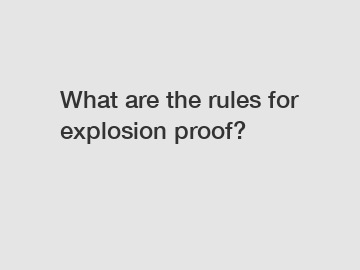Jan. 16, 2024
Lights & Lighting
What are the rules for explosion proof?
Explosion-proof equipment is designed to prevent the ignition of flammable gases and dust particles in hazardous environments. These environments can include chemical plants, oil refineries, mining operations, and other locations where volatile substances are present. It is vital to understand the rules and regulations surrounding explosion-proof equipment to ensure the safety of workers and prevent potential tragedies. In this article, we will explore the primary guidelines and regulations that govern explosion-proof equipment.
Classification of Hazardous Locations.

Before we delve into the rules for explosion-proof equipment, it is essential to understand the classification of hazardous locations. Hazardous locations are divided into different classes, divisions, and zones based on the nature and degree of the potential hazards. The classification system helps determine the necessary explosion-proof equipment required for each specific location.
Classes: Hazardous locations are classified into four main classes. Class I represents areas with flammable gases or vapors such as gasoline or natural gas. Class II is for locations with combustible dust particles. Class III refers to areas with ignitable fibers or flyings.
Divisions: Divisions further define the level of risk within each class. Division 1 indicates that hazardous materials are present under normal conditions, while Division 2 means they are only present in abnormal situations like leakage.
Zones: Zones apply to international standards and are similar to divisions. Zone 0 indicates the highest level of risk, where hazardous materials are present continuously. Zone 1 refers to locations where hazardous substances can be expected intermittently, and Zone 2 is where hazardous substances are unlikely to occur but may be present for short durations.
Explosion-Proof Equipment Standards.
Several organizations have established standards and guidelines for explosion-proof equipment to ensure its reliability and safety. The most commonly recognized standards include:
1. National Electric Code (NEC): The NEC provides requirements for electrical installations in hazardous locations within the United States. It outlines the appropriate wiring methods, equipment ratings, and other safety measures.
2. International Electrotechnical Commission (IEC): IEC standards are widely accepted internationally and provide guidance on explosion-proof equipment design, testing, and certification.
3. International Organization for Standardization (ISO): ISO standards address various aspects of explosion-proof equipment, including design, performance, and testing methods.
4. National Fire Protection Association (NFPA): NFPA offers guidelines and codes that promote the safe use of equipment and materials in hazardous environments.
Requirements for Explosion-Proof Equipment.
Explosion-proof equipment must meet specific requirements to ensure its effectiveness in hazardous locations. Some of the key requirements include:
1. Construction: Explosion-proof enclosures must be robust and tightly sealed to prevent the entry of flammable gases or dust particles. They should also be able to withstand internal explosions without causing external damage.
2. Containment: Explosion-proof equipment should have the ability to contain any explosions that might occur within the enclosure. This prevents sparks or flames from escaping and igniting the surrounding atmosphere.
3. Temperature: Components of explosion-proof equipment should operate at temperatures lower than the ignition point of hazardous materials.
4. Certification: All explosion-proof equipment must undergo rigorous testing and certification by authorized bodies to ensure compliance with the relevant standards.
Conclusion.
Understanding the rules and requirements for explosion-proof equipment is crucial to maintaining a safe working environment in hazardous locations. Compliance with the appropriate standards ensures that the equipment can effectively prevent and contain explosions, protecting both workers and the surrounding environment. If you have any questions or require further information, please do not hesitate to contact us.
(Contact us for more information regarding explosion-proof equipment and its regulations.).
For more information, please visit waterproof flourescent light, explosion proof potentiometer, explosion proof distribution panel.
If you are interested in sending in a Guest Blogger Submission,welcome to write for us!
All Comments ( 0 )